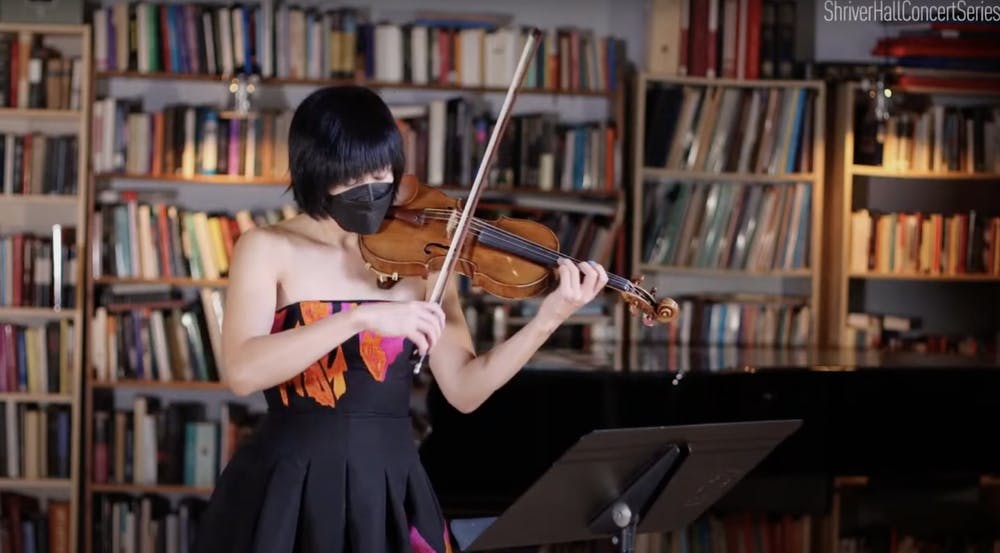The Johns Hopkins News-Letter
By Sara Jung
April 22, 2021
original link
Violinist Jennifer Koh portrays the pandemic through performance
 COURTESY OF SARAH JUNG
COURTESY OF SARAH JUNGJennifer Koh performs her project Alone Together and two pieces written by J.S. Bach.
Violinist Jennifer Koh gave a powerful performance for the Shriver Hall Concert Series on April 11. Koh performed selections from Alone Together, a project she started when the pandemic began. Her rendition of Ellen Reid’s “Brick Red Mood” was unusual because of its resemblance to an assembly of discordant notes that sounded like someone screaming. This piece opened my eyes to a form of classical music I had never encountered prior.
Uncertain of its meaning, I pondered on the title “Brick Red Mood.” The melancholic tone of the piece seemed to represent a heart-wrenching feeling.
Out of selections from Alone Together, another piece that struck me was Patrick Castillo’s “Mina Cecilia’s Constitutional.” Again, I was unsure of what the title was suggesting, but I appreciated the high-level hand techniques required for the piece.
The piece began with the rapid crossing-over of strings using harmonics, which gave it an airy feeling. In one part of the piece, her left hand slid up and down the fingerboard of the violin, creating an eccentric, slippery sound.
She also performed Cassie Wieland’s “Shiner.” I was in awe of the vivid image created by the sounds embedded in this piece. The sharp and short pizzicato notes were like speckling stars in the sky, perhaps which was what the title of the piece was referring to. The following short strokes of the bow accentuated the night scene created by the pizzicato.
From another series of selections from Alone Together, I found Koh’s performance of Katherine Balch’s “Cleaning” very memorable. She switched from her violin bow to a purple latex glove and simulated the cleaning of the violin by rubbing against the string vigorously. A squeaky sound emanated from the violin, followed by a slight tapping, which sounded like water droplets. The piece ended suddenly in a pizzicato stroke of all four strings.
The final series of selections from Alone Together was composed of two pieces. Of the two, I was intrigued by Darian Donovan Thomas’“Art/Nat” with electronics by Ian Chang. Koh’s violin notes served as a background for a voiceover that was played on top. It was a string of words that alluded to a time of change.
Koh also performed J.S. Bach’s classic Violin Partita No. 3 in E major, “Bach-Werke-Verzeichnis 1006.” Compared to other performances of this piece, such as those given by Hilary Hahn, Koh packed each note with more force. My perception of the piece quickly changed from “elegant” to “passionate” after watching her unique performance.
An artist’s conversation followed the performance. Here, Koh expanded on her motivations behind playing Bach.
“I chose E major Partita because that was the first solo Bach that I ever played as a child,” Koh said. “Bach is one of the composers who has stayed with me throughout my life and was important to me.”
She then elaborated on her choice of E major Partita. Koh explained that she was imagining rebirth after the pandemic and looking forward to celebrating life with people, a feeling that could be relatable for many.
“Playing solo violin is solitary. It’s like a personal journal or emotional archive,” Koh said. “Sharing it feels like one is presenting a vulnerable side, and there is something beautiful about communication where it makes us feel safe enough to be able to share.”
She also expressed her desire help artists who have been affected by the pandemic. She also called attention to the need to encourage new artists to continue their work in order to prevent the loss of the upcoming generation of artists. Her board was able to micro-commission 20 freelance composers recommended to her by her colleagues.
“Artists can imagine a path out [of constraints] and lead us to an ideal world,” Koh said. “We can allow the idea of expansion to include people who haven’t necessarily been heard before in classical music.”
Koh highlighted how music can be used as a form of activism, pointing to her colleagues who wrote about police violence through music. In turn, she encouraged that we all listen to each other’s stories.
Despite the pandemic’s downsides, I thought Koh was able to draw out the positives of life and pass on lessons she learned as a solo violinist. Just as Koh emphasized, we should all lend our ears to people in our community and take the time to learn about their struggles, especially when hardships hit.
Copyright © The Johns Hopkins News-Letter
© Jennifer Koh, All Rights Reserved. Photography by Juergen Frank. Site by ycArt design studio